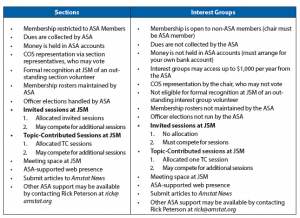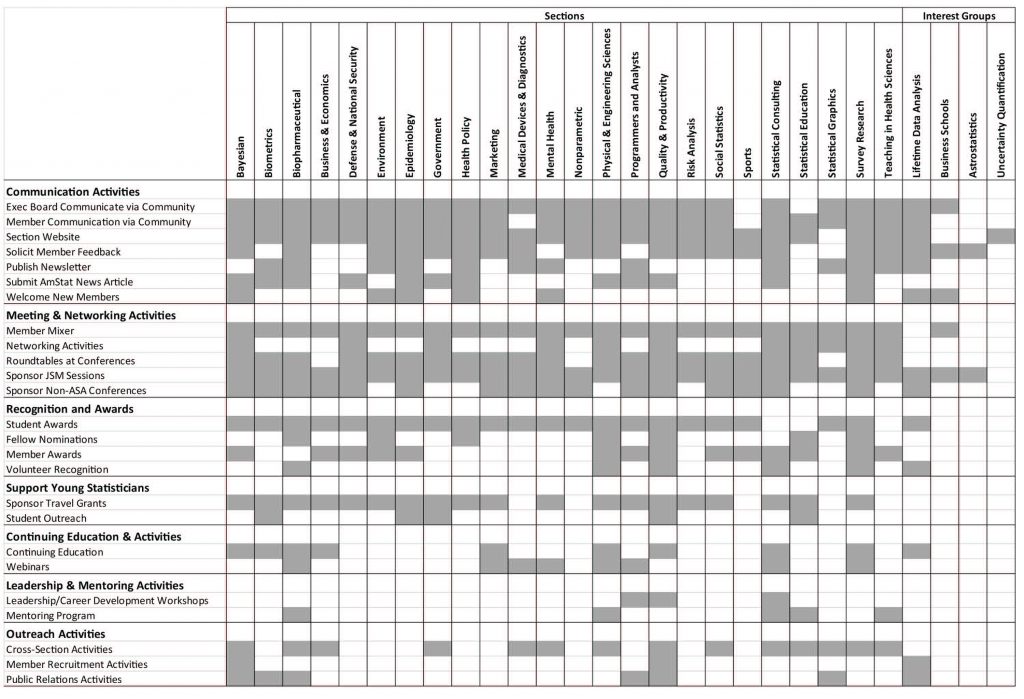To Join or Not to Join A(nother) Section or Interest Group?
2018 ASA Council of Sections Governing Board Members
If you are a history buff, you probably already know when ASA sections were created (and that there is a History of Statistics Interest Group). According to “History of the ASA,” sections were created following WWII to “focus on specific business interests such as engineering, economics, social sciences, and education.” Today, ASA sections are still doing what they were chartered to do, but with an expansion of topics and interests.
Unlike sections, however, interest groups are relatively new to the ASA. They focus on topics as sections do, but there are important differences. Table 1 provides a detailed comparison of the two.

Table 1—A Comparison of Sections and Interest Groups
There are currently 29 sections and nine interest groups. Does the number 29 surprise you? Did you think there were only 28 sections? There were only 28 sections until recently, when our newest section—the Lifetime Data Science (LiDS) Section (formerly the Lifetime Data Analysis Interest Group)—was established. The Council of Sections recently approved its petition to become a section.
Now that you are familiar with sections and interest groups, let’s go back to the original question. Should you join a section or interest group? There are many reasons—keeping up to date, networking, advocacy, education, leadership, member awards, etc.—and there are articles that have been published in Amstat News about the benefits (August 2016, “Benefits of ASA Section Membership”). Rather than repeat those ideas here, we thought we would show you the data from the 2017 Council of Sections Annual Report to help you decide which sections and interest groups would be valuable to you.
For many years, sections have been asked to create an annual report. In 2017, the report was modified and a simple, short questionnaire was created. Sections and interest groups were asked to update their three promotional bullets included in the informational slides on sections and report on their activities. The full report is available on the Council of Sections webpage.
The cell plot (Figure 1) shows the activities of the sections and interest groups that responded to our questionnaire. (Four sections and four interest groups did not reply.) The rows of the cell plot describe the activities a section might support, and the columns list the sections and interest groups that sent their annual report. A grey cell means the section or interest group on that column participated in the activity listed on that row.

Figure 1: Results from the 2017 Council of Sections Annual Report, indicating the self-reporting from the participating section and interest group on their activities.
This report offers an overview of the activities, identified areas of strength, and identified areas to develop to the COS. It also gives section and interest group leaders a way to see what others are doing and who they might talk to if they are interested in starting an initiative. (For example, many sections seem interested in either starting or improving their mentoring program. If this is something of interest to you and you haven’t seen the special edition of The American Statistician that focuses on mentoring (February 2017), it is worth taking a look.) The feedback we have received about the annual report has been positive, and it is something we will do again in 2018.
There are a few other activities that might be of interest to you as you make your decision about whether to join or become more involved in a section or interest group. At JSM 2018, the COSGB sponsored a workshop that focused on leadership skills for executive members of sections and interest groups, and we plan to continue offering these leadership workshops. Also, in 2019, we will start a volunteer recognition award for sections. Once every three years, on a rotating basis, a section will be able to recognize a section member for outstanding volunteer service.
If you still aren’t sure about joining a section or interest group, let us motivate you a bit more. It’s free! Well, you have the option to try out a new section for a year for free, and then dues range from $5 to $12 annually. It is a great value, and you are helping to advance the profession.
If you have any questions about the activities of the Council of Sections, feel free to contact anyone on the Council of Sections Governing Board.
Interest groups are similar to sections in that they are formed based on a particular statistical theory, methodology, or application that is sufficiently broad to represent active professional interests within the scope of the ASA. In fact, sections must start as an interest group, and then they may choose to petition to become a section after three years. Read more about the benefits of ASA section membership.

















